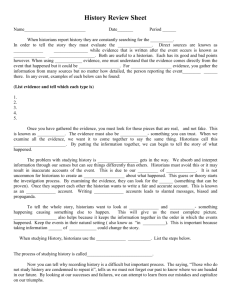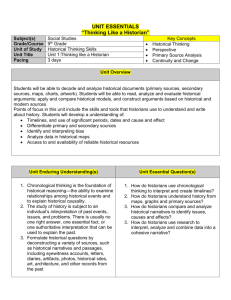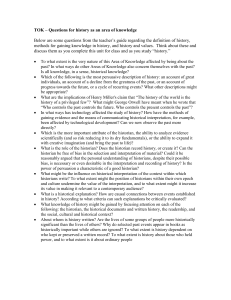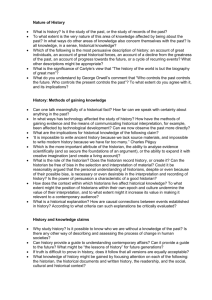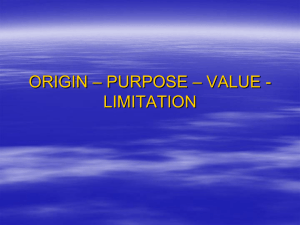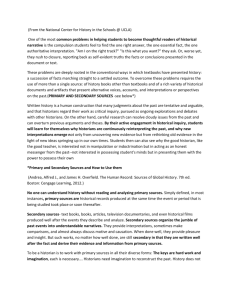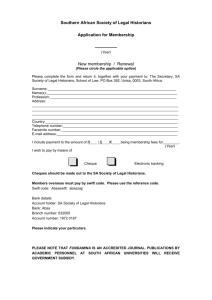US History 1301: M06: United States History: Colonial
advertisement
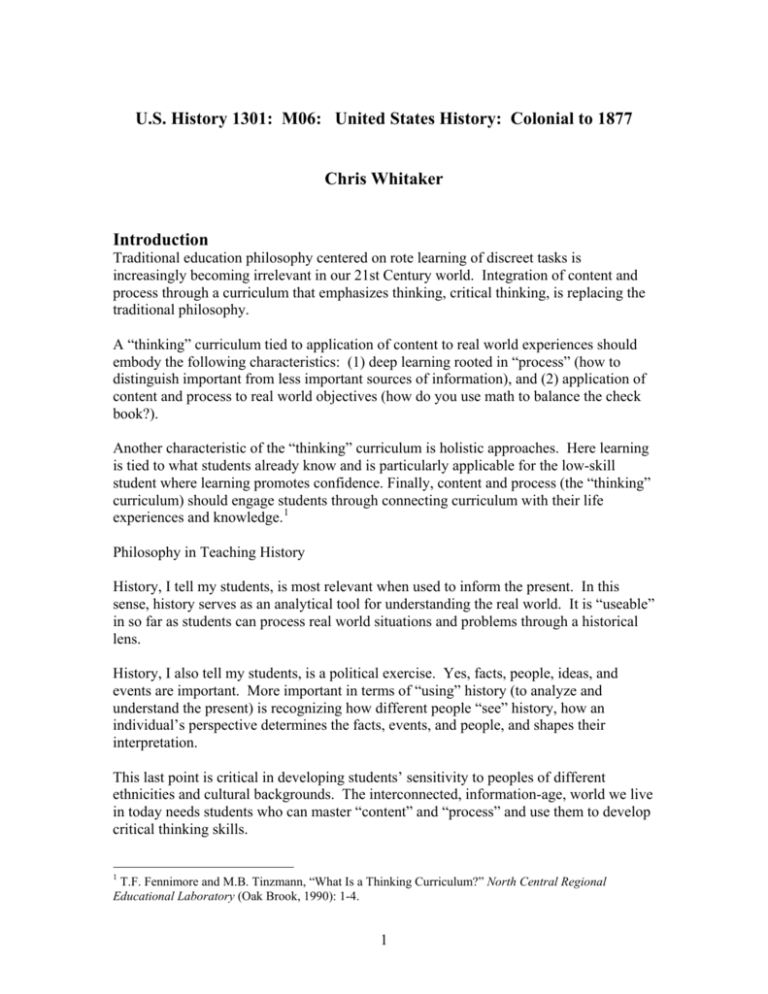
U.S. History 1301: M06: United States History: Colonial to 1877 Chris Whitaker Introduction Traditional education philosophy centered on rote learning of discreet tasks is increasingly becoming irrelevant in our 21st Century world. Integration of content and process through a curriculum that emphasizes thinking, critical thinking, is replacing the traditional philosophy. A “thinking” curriculum tied to application of content to real world experiences should embody the following characteristics: (1) deep learning rooted in “process” (how to distinguish important from less important sources of information), and (2) application of content and process to real world objectives (how do you use math to balance the check book?). Another characteristic of the “thinking” curriculum is holistic approaches. Here learning is tied to what students already know and is particularly applicable for the low-skill student where learning promotes confidence. Finally, content and process (the “thinking” curriculum) should engage students through connecting curriculum with their life experiences and knowledge. 1 Philosophy in Teaching History History, I tell my students, is most relevant when used to inform the present. In this sense, history serves as an analytical tool for understanding the real world. It is “useable” in so far as students can process real world situations and problems through a historical lens. History, I also tell my students, is a political exercise. Yes, facts, people, ideas, and events are important. More important in terms of “using” history (to analyze and understand the present) is recognizing how different people “see” history, how an individual’s perspective determines the facts, events, and people, and shapes their interpretation. This last point is critical in developing students’ sensitivity to peoples of different ethnicities and cultural backgrounds. The interconnected, information-age, world we live in today needs students who can master “content” and “process” and use them to develop critical thinking skills. 1 T.F. Fennimore and M.B. Tinzmann, “What Is a Thinking Curriculum?” North Central Regional Educational Laboratory (Oak Brook, 1990): 1-4. 1 LEE COLLEGE OFFICE: SS 228 EMAIL: cwhitake@lee.edu OFFICE HOURS: M-TH: HIST. 1301: M06. 7:15-8:15 am T: 3:30-4:30 pm Or by appointment. Christopher Whitaker, M.A. TELEPHONE: 832-556-4055 DIVISION CHAIR: Dr. Steve Showalter, SS 207 PHONE……………281-425-6372 DIVISION SECRETARY: Marian Stein, SS 209 PHONE……………281-425-6371 CHIEF ACADEMIC OFFICER: Mr. Bruce Scism, TV1 PHONE……….281-425-6440 COURSE PURPOSE: To enable students to think historically about patterns, themes, and processes in America from 1500 to 1877. KEY QUESTION(S): What are the major themes, patterns and processes constituting American history from 1500 to 1877? INFORMATION: Students will understand, and, at times use, primary and secondary sources. SKILLS OF INTERPRETATION: Students will master an ability to acquire and interpret historical information from a variety of sources. ASSUMPTIONS: It is possible for entry level community college students to use themes, patterns and processes in America, 1500 to 1877, in understanding complex issues in today’s world. IMPLICATONS: Students who develop an understanding of the major events in American history should be able to make connections to events in 21st-century America. POINT OF VIEW: Students will learn “reasoning historically” is a matter of perspective. That said students will learn to reason both as a “conservative” and a “liberal”. 2 • READING MATERIALS: Textbook: Tindall and Shi, America, 7th ed. Additional Books: Annual Editions. Vol. 1 Narrative of the Life of Fredrick Douglass CLASSROOM RULES: • • • • • CELL PHONES ARE PROHIBITED DURING IN-CLASS EXAMINATIONS! During regular class sessions (non-testing days) cell phones should be on “silent” or “meeting” mode. Students who refrain from letting their cell phone ring in class will be awarded three additional points; conversely, students who let their cell phones ring and disrupt class will not be awarded the three points: subsequent disruptions will result in students’ losing three points. MAKE-UPS WILL ONLY BE PERMITTED IN CASES OF DOCUMENTED EMERGENCIES, emergencies conveyed to the instructor BEFORE THE CLASS! A paper or book review with an oral presentation can be assigned—at the instructor’s discretion--for any student who misses more than one exam. VIOLATION OF LEE COLLEGE ACADEMIC HONESTY POLICY will result in a failing grade for the assignment in question: this is for the first offense. Subsequent offenses result in a failing grade for the course, and possible College suspension. Please understand and become familiar with the Lee College Academic Honesty Code (see www.lee.edu/acad_honesty.asp ). REGULAR ATTENDANCE IS MANDATORY: All students are expected to attend classes regularly. More than three hours of missed class time (missed due to undocumented emergencies) can result in a student being dropped from the course— this is a Lee College policy. Tardy attendance will be counted as an absence. SPECIAL CONCERNS: Please note the following classroom behaviors will result in students being marked absent: (1) Using computer/electronic devices such as, but not limited to, IPODs, MP3 players, Blackberries (and other hand-held computers) during lecture and discussion, (2) sleeping in class, and (3) excessive chatting. GRADE DETERMINATION: 9 Three unit exams will make up 55 % (or five hundred and fifty points) of the grade in this class. Students will be provided a review document for all unit tests at least one week prior to unit tests. Several types of questions will be used to test students’ memorization of factual information, as well as ability to analyze and critically evaluate learned historical knowledge. To that end, students will have a combination of multiple choice, matching, lists (critical thinking and memorization), and chronology exercises. The last unit test will not be cumulative. 3 9 Lee College requires all history students to complete an acceptable library assignment. For this class the assignment will be a book review worth 15% (150 points) of the total points. This library assignment will be due no later than Tuesday, April 24. Instructor approval of an appropriate book is required. Important note on the library assignment: since the library assignment is a departmental requirement, any student who fails to complete it, or who violates the Academic Honesty Code (through plagiarism, misrepresentation, etc.) will receive no higher than a “D”. 9 Students will be required to take pre-and post-Nelson-Denny Reading and California Critical Thinking Skills tests. Keep in mind, our class has been selected for evaluation of Lee College’s “critical thinking” and “reading” Quality Enhancement Plan—the QEP. Our goal is to complete the pretesting no later than the second week of class, the post-testing sometime in late April. Thank you in advance for your participation to improve critical thinking and reading skills across the curriculum. 9 Seven quizzes will make up 25% (250 points) of the total points. • All quizzes (except the map quiz) will be a combination of identification questions (from online textbook chapter flashcards) and short answer/short paragraph questions from supplemental books. Reading for the first five quizzes will come from Annual Editions. For quizzes seven and eight Fredrick Douglass. The map quiz will be given in conjunction with the final exam. • Points and grading policy for the different quizzes. The highest four Annual Editions quizzes, along with Fredrick Douglass and the map quiz will be included in the point total (250). (The lowest quiz score from Annual Edition will be dropped.) The first five quizzes will be worth twenty-five points: ten from online textbook flashcards, fifteen from Annual Editions. The last three quizzes (Fredrick Douglass map quiz) will be worth fifty points each, or 150 total points. (Quizzes six and seven will be ten points from flashcards, forty from Fredrick Douglass.) 9 Critical Thinking Assignment: 50 points 9 Final grades will be based on a percentage of 1000 points: A: 900 to 1000 points B: 800 to 899 C: 600 to 799 D: 500 to 599 F: below 500 DROP DATE The last date to drop this class (and all sixteen week classes) is 13 April. 4 Practice 1: Source Analysis and Methodology. This is one element—one part—of a Book Review Assignment (instructions are handed out during the first week in class). This element asks students to analyze sources, then, based on the analysis, make sound assumptions and logical inferences concerning the author’s “methodology(ies)”. The boldfaced type indicates key questions embedded in this critical thinking assignment. Primary and secondary sources: what are they? In this section students need to identify key sources used by their author. Most professional historians try to rely on “first-hand” or primary sources to “get as close to the event, person, or concept” as possible. For that reason students should try and find “key” primary sources. (Hint: sometimes the historian will have a “Note on Sources” where comments on key sources will make your task all-the-more straightforward) Historians use secondary sources (sources “after the fact”) to show how other historians have “interpreted” the primary sources. Historians also use secondary information to inform their research methodologies (see below, methodologies). A bibliography (if your book has one) will list all sources in alphabetical order; most bibliographies in historical monographs also separate the “primary” or “firsthand” from the “secondary” or “second hand” sources. Many secondary monographs, however, have only “endnotes” or “footnotes” (books with bibliographies usually have both a bibliography and endnotes/footnotes). This type of documentation makes the task of distinguishing primary from secondary tricky. As a general rule, however, check “publication dates” from the sources in the footnotes/endnotes. This will help distinguish the primary information from secondary. “First-hand” or primary sources: Examples of primary sources are: oral interviews, pictures, tax records, diaries, letters, newspaper articles, court proceedings, Congressional sessions, church rolls, hospital records, etc. Our library class will help further understanding of what constitutes primary sources. After understanding and determining sources answer these questions: Does the author base their thesis more on primary or secondary sources? And more importantly, what do you think the key primary and/or secondary sources are? (Remember most professional historians try to base their research from primary sources, so, in most cases, the key sources are primary) Historical Methodology: A Definition Historians are not wedded to one particular research field; historians borrow research strategies from other disciplines (sociology, anthropology, archaeology, economics, psychology, political science, humanities, philosophy, biological sciences, linguistics, etc.) Based on secondary sources and key concepts acquired in your reading what assumptions can you make concerning methodologies of your historian? 5 Like source analysis sound assumptions about methodologies can be difficult to detect. Some historians, however, are explicit in informing the reader what disciplines—fields of study—they employ (often this information is found in the Preface or Introduction); for others “sound” assumptions will be more difficult to make—they require more close reading and understanding of the sources and key concepts. Practice 2: Assumptions and Inferences about the “Personal” and “Political” Biases of your Author. This assignment requires students to make sound assumptions and logical inferences about their author’s personal values and beliefs; make a sound assumption concerning the author’s preference for what constitutes social change; and make a sound assumption concerning your author’s perspective and/or point-of-view. This is another component of the Book Review Assignment (see above). Again, like Practice 1, the boldfaced type indicates key questions embedded in this critical thinking assignment. Personal Values and Beliefs: Students should determine the approximate time period—the generation—when your author was a young adult (approximately eighteen to thirty). The young adult years are likely formative years shaping your authors personal values and beliefs. Using your textbook, Oxford Online Premium, or other research sources, find-out what important events/people/ideas punctuated your author’s generation. Combine the “formative year” research with biographical research on your author. Come up with at least two sound assumptions and one logical inference referencing your author’s personal values, and personal beliefs. Assumptions about social change: Part of the nature of history and historians is to describe, explain and undercover social change. How society changes is directly dependent on assumptions historians make concerning change. Some of the more influential beliefs are: economic forces (the free market), social classes (conflict between the rich and poor), great leaders (Martin Luther King), and ideas (feminism, communism, capitalism). Your key question here: what category of social change does your historian fall in? Is he/she an economic historian? political historian? historian of ideas? class-conflict or Marxist (or neo-Marxist) historian? Make one sound assumption in a declarative statement. Point of view and perspective: A point-of-view is a way of considering something. “From a medical point view……” Similarly “perspective” in a historical context is a way of “seeing” or “viewing” the past. Often historians’ perspective and point-of-view are interchangeable, that is the author’s point-ofview and perspective are essentially the same. Historians often state their perspective/point-of-view in the introduction (or preface). In other words, they explicitly state how they “view” their subject 6 (from a comparative, global, regional perspective, etc.), they state what voice they are attempting to use in approaching his/her subject? In a book about slavery, for example, is the historian devoting his/her book to how slaves “perceived” slavery? How the elite plantation owner “perceived” slavery? How the 1830’s white working class in the North “perceived” slavery? Make one sound assumption characterizing your historian’s perspective/point-of-view. Your assumption here should be supported by the sound assumptions and a logical inference you determined about your author’s personal values and beliefs. Practice 3: Conflicting Visions for America? Hamilton and Jefferson The following assignments have students think critically about two prominent Founding Fathers: Alexander Hamilton and Thomas Jefferson. The structure for these questions come from active learning—Socratic questioning in particular—over problems facing the young nation, problems in the period after the end of the Revolutionary War, before ratification of the Constitution (1788). The other pole surrounding context for these questions (see below) is structured on a brief outline of the respective “visions” of each of the Founding Fathers. The questions are given in a review document and students are asked to write short essays. Structure One: Students identified (through reading, clarification from class discussion, and from questioning the questioner) major problems—international and domestic, general and specific--facing the young nation. Structure Two: Key components from the Hamiltonian and Jeffersonian visions: A. Hamiltonian Vision: 1. Loose construction of the Constitution (meaning? The Constitution should be interpreted loosely, esp. the “Necessary and Proper Clause” in Article 1 Sect. 8) 2. A natural aristocracy based on merit should govern and participate in political life. 3. The United States Government should look to England for commercial and political guidance. 4. America should be a commercial, urban nation, where trade and manufacturing would provide the economic base. 7 B. Jeffersonian Vision: 1. Strict construction of the Constitution (…Constitution interpreted narrowly) 2. The masses should be allowed to govern and participate in political life. 3. The U.S. Government should look to France for ideological and political guidance. 4. America should be a nation of small, self-sufficient farmers. (Jefferson’s “agrarian paradise”) Students should argue three points in each vision, and use critical thinking skills (see below) to advocate why each vision would provide the best blueprint, the best guidance for the new nation. The Questions and Preparation (given to student one week before the test, along with other types of “memorization” questions): 1. Argue why the “Jefferson vision” provided the best blueprint, the best guidance for the new nation (the best guidance in terms of creating stability and security for a fragile nation) 2. Argue why the “Hamilton vision” provided the best blueprint, the best guidance for the new nation (the best guidance……) For both of these critical thinking lists students should be familiar with the “visions” of the two Founding Fathers, understand key information and concepts (during the early years of the Republic), and be able to make sound assumptions and logical inferences. Make sure you read Chapter 8 very closely (here the Jefferson and Hamilton “visions” are discussed in some detail); Chapters 9 and 10 would also be helpful: the more “relevant” information you can put into your essays, the better you can argue and substantiate your points. 8 9


